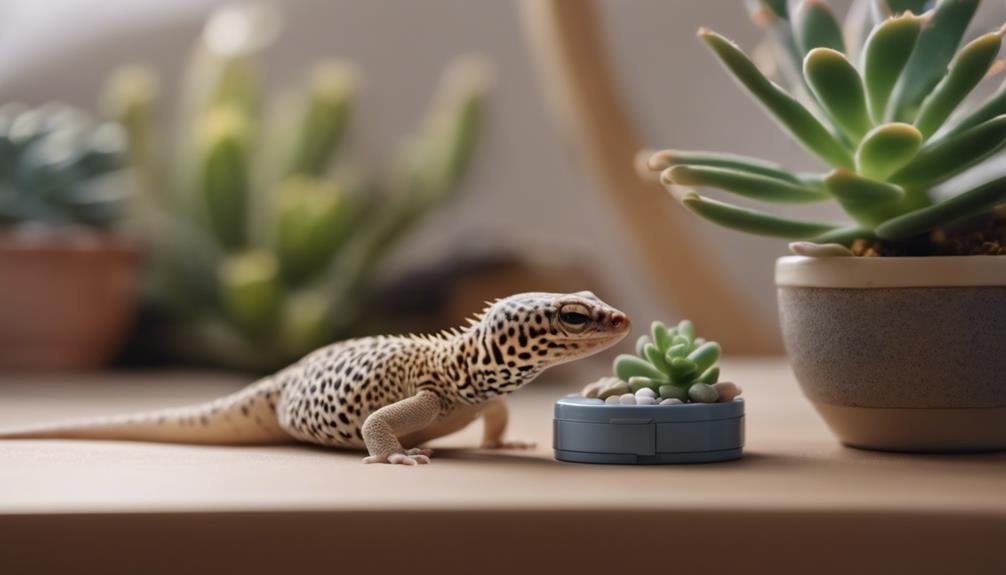If you’re a leopard gecko owner, witnessing your pet lose its tail can be startling, yet it’s important to know this is a natural defense mechanism and doesn’t cause the gecko pain. However, what you do next plays a significant role in its recovery. Ensuring a sterile environment and proper dietary adjustments are just the beginning steps. You might find yourself wondering about the intricacies of tail regeneration or how to prevent future occurrences. With the right approach, supporting your gecko through this process can be straightforward, but there are essential considerations you shouldn’t overlook. Let’s explore what those are.
Key Takeaways
- Leopard geckos experience minimal to no pain during tail loss due to their natural defense mechanism, autotomy.
- Immediately post-tail drop, provide a clean, stress-free environment to let the gecko calm down and start the healing process.
- Clean the wound with a mild disinfectant and replace vivarium substrate with paper towels to prevent infection.
- Adjust the gecko’s diet to include calcium-rich foods and necessary supplements to support healing and tail regeneration.
- Monitor the gecko for signs of infection or distress and consult a veterinarian for professional advice and care.
Understanding Tail Loss
When a leopard gecko faces danger, its unique defense mechanism, autotomy, kicks in, allowing it to shed its tail and escape predators unharmed. This fascinating process, known as tail loss, doesn’t cause the gecko pain, thanks to its biological design specifically for survival. The tail acts as a decoy, giving the gecko a chance to flee while the predator is distracted.
As a caretaker, it’s important to understand that although autotomy is a natural defense mechanism, the aftermath requires specific attention. Geckos can regrow their tails, a process that highlights their remarkable resilience. However, the new tail often looks different, perhaps in color, texture, or size, which is entirely normal.
This regrowth process emphasizes the importance of post-tail care. Caretakers need to make sure the gecko’s environment is clean and stress-free to avoid infection and promote healing. Understanding the intricacies of autotomy and its effects on your gecko will help you provide the best care possible during their recovery. Tail loss and the subsequent regrowth period are evidence of the gecko’s incredible adaptability, but it also highlights the responsibility of caretakers to support their pet through this regeneration phase.
Immediate Actions Post-Drop
After your leopard gecko drops its tail, the first step is to give it time to calm down, ideally for about 30 minutes. This period allows your pet to recover from the stress of tail dropping, an important immediate action to guarantee its well-being.
While it’s calming down, use this time to prepare its environment for recovery.
Next, you’ll need to focus on creating a safe and clean recovery space. Remove any dirt or debris from the immediate area around the wound to help prevent infection, but remember, detailed cleaning and wound care will come later. For now, it’s all about setting up a conducive healing environment.
Swapping the substrate in its vivarium is a significant immediate action. Replace any loose substrate with paper towels to prevent particles from entering the wound and complicating the healing process. The clean vivarium with paper towels not only offers a sterile environment but also makes monitoring the wound and any changes in it easier for you.
Lastly, ensure the vivarium remains a quiet, stress-free zone. This supportive environment is essential for your leopard gecko’s recovery from tail loss, aiding in both physical healing and stress reduction.
Cleaning and Wound Care
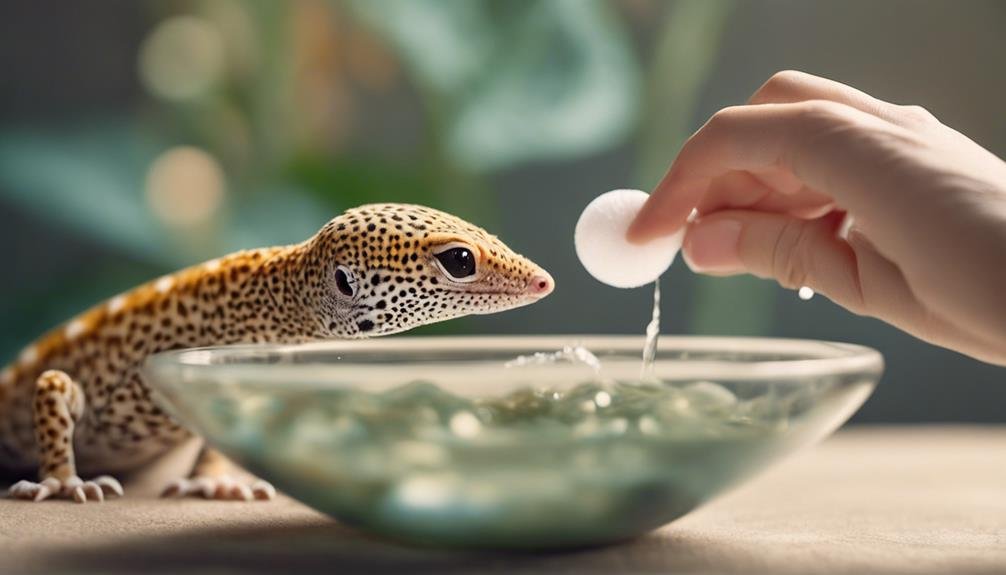

Having established a stress-free recovery space, it’s time to focus on cleaning and caring for your leopard gecko’s wound effectively. After your gecko loses its tail, the first step in wound care is to gently clean the area with a mild disinfectant. This initial cleaning is important to prevent infections that can complicate the healing process.
Next, consider the substrate in your gecko’s enclosure. Replace any loose substrates with paper towels to maintain cleanliness around the wound. Paper towels not only aid in keeping the area clean but also prevent small particles from getting into the wound, which could lead to infections or other complications.
Monitoring the wound for signs of infection is an essential part of wound care. Keep an eye out for redness, swelling, or any oozing of pus, as these symptoms indicate that the wound might be getting infected. A clean vivarium plays a significant role in the healing process, providing a safe and quiet environment that minimizes stress for your leopard gecko. Regular cleanliness and careful monitoring will support a smoother recovery after the loss of a tail.
Setting Up a Recovery Area
To ensure your leopard gecko‘s swift recovery after losing its tail, you’ll need to set up a quiet and safe recovery area with minimal disturbances. Opt for a clean vivarium and line it with paper towels as a substrate. This setup not only helps to prevent tail infections but also makes it easier for you to monitor the healing process. Steering clear of loose substrates is vital; they can embed in the wound and hamper healing, complicating your leopard gecko care routine.
Ensure the tank is kept at an appropriate humidity to make sure the environment is conducive to healing the dropped tail and fostering the growth of a new tail. The humidity plays a pivotal role in preventing the wound from drying out and becoming prone to infection.
Keep your leopard gecko solo in this recovery area. This minimizes stress, allowing for uninterrupted healing. You’ll also need to keep a vigilant eye on your gecko for any signs of infection or complications. Quick identification and response to these signs are imperative in ensuring a smooth and swift recovery process.
Dietary Adjustments
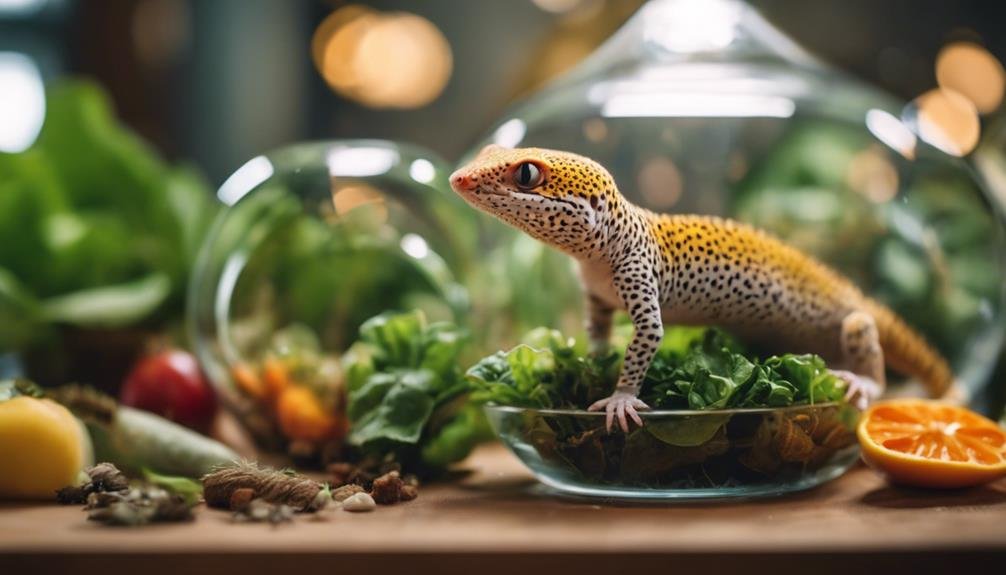

In addition to setting up a safe recovery area, adjusting your leopard gecko’s diet plays a vital role in its healing and energy replenishment post-tail loss. After your gecko loses its tail, it’s important to focus on providing a diet that supports recovery. This means incorporating calcium-rich foods that aid in the healing process and promote healthy tail regrowth. It’s not just about what you feed, but also how you supplement the diet. Adding appropriate nutritional supplements can guarantee your gecko maintains overall health during this critical time.
Monitoring your gecko’s eating habits becomes more crucial than ever. You’ll want to make sure it’s consuming enough food and getting a balanced diet to replenish lost energy reserves and support cell regeneration. This is a time when your pet needs all the nutrition it can get, so paying close attention to its dietary needs is paramount.
Providing a consistent and balanced diet is fundamental for your leopard gecko’s recovery. By focusing on calcium-rich foods and ensuring the inclusion of necessary nutritional supplements, you’re setting the foundation for a swift and healthy recovery process.
Monitoring for Complications
After your leopard gecko loses its tail, it’s important you keep an eye out for any signs of infection or poor healing. You’ll need to look for redness, swelling, or pus around the tail stump, and make sure they’re eating properly and behaving normally. If anything seems off, it’s time to consult a veterinarian to help your gecko heal without complications.
Identifying Infection Signs
Recognizing the signs of infection, such as redness, pus, and swelling at the tail wound site, is essential for your leopard gecko’s recovery. After a tail loss, monitoring the wound for any unusual changes is important. Infections can escalate quickly, necessitating prompt veterinary intervention. Keeping the area clean and disinfected helps in preventing unwanted bacterial or fungal growth.
To safeguard your gecko’s well-being, look out for:
- Redness and swelling indicating inflammation
- Pus or unusual discharge signifying infection
- A foul odor emanating from the wound site
- Increased sensitivity or pain in the affected area
If you observe any of these signs, it’s critical to seek professional advice. Early detection and treatment can prevent complications, ensuring a smoother recovery for your pet.
Promoting Healthy Regrowth
To ensure your leopard gecko’s lost tail regrows healthily, you’ll need to closely monitor the stump for any infection signs, such as redness or oozing of pus. After your gecko drops its tail, the regrowth process demands your vigilance. Keep an eye out for swelling or other signs of infection at the tail stump.
Ensuring your gecko receives proper nutrition is vital for both regrowth and overall health. A clean environment is also key to preventing complications. Remember, the new tail may look different in color or texture, but that’s normal.
If you notice anything unusual or if the tail stump doesn’t seem to be healing properly, don’t hesitate to seek veterinary advice. Your proactive care will support your gecko through a successful recovery.
Promoting Tail Regeneration
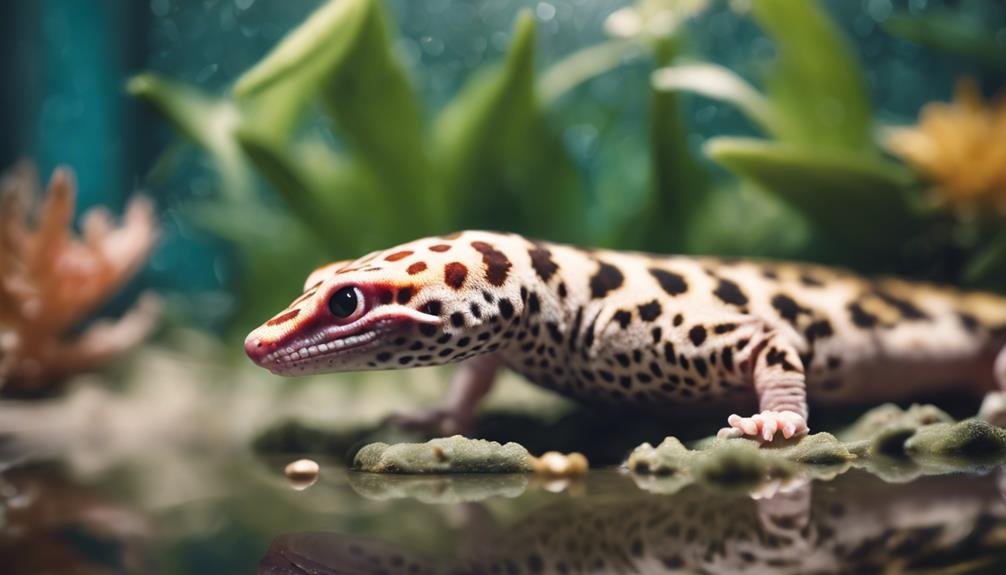

Ensuring your leopard gecko has a stress-free environment and proper nutrition is essential for promoting healthy tail regeneration. After your gecko loses its tail, the focus shifts to supporting the regrowth process, which can range from several weeks to months. This period is critical, and your attention to their care can make a significant difference in the outcome.
To facilitate this, consider the following:
- Offer a varied diet rich in essential nutrients to boost their overall health and aid in the regrowth.
- Maintain a clean enclosure to prevent any risk of infection at the site of the lost tail.
- Monitor the regenerating tail for any signs of infection or abnormal growth patterns.
- Ensure the habitat minimizes stress, incorporating hiding spots and maintaining ideal temperature and humidity levels.
Preventing Future Tail Loss
Identifying and mitigating stress factors is vital to preventing future tail loss in leopard geckos. You’ve got to keep an eye on your gecko’s environment and behavior to spot any signs of stress early. Proper handling is paramount; remember, never grab your gecko by the tail. Instead, support its body to minimize distress and the risk of tail dropping.
Creating a stress-free habitat is essential. This means paying attention to the temperature, humidity, and lighting within the enclosure. If you’re not sure about the ideal conditions, it’s a good idea to seek veterinary advice. They can offer guidance tailored to your gecko’s specific needs, helping you prevent tail loss from happening again.
| Factor | Action | Goal |
|---|---|---|
| Environment | Monitor regularly | Detect stressors early |
| Handling | Avoid tail grabbing | Reduce distress |
| Habitat | Optimize conditions | Support tail retention |
| Behavior | Observe changes | Early detection of stress |
| Veterinary Advice | Seek when necessary | Tailor prevention strategies |
When to Consult a Vet
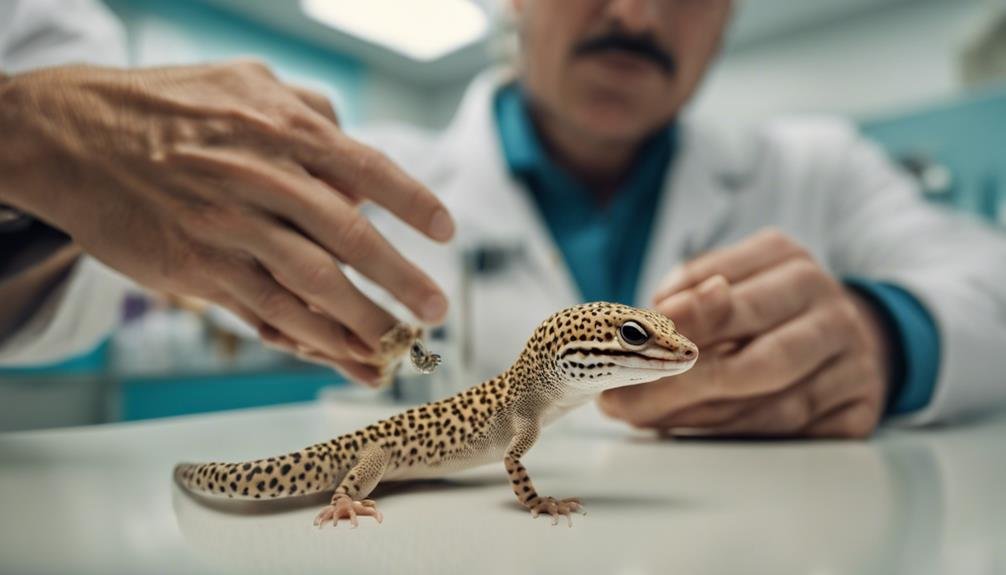

If your leopard gecko loses its tail and shows signs of infection or distress, it’s time to consult a vet. Tail loss in leopard geckos is a natural defense mechanism, but the aftermath requires careful attention to prevent complications. Reptile vets, with their specialized experience, can offer the appropriate diagnosis and treatment to guarantee your pet’s quick recovery and well-being. Recognizing when to seek professional help is vital for the health of your gecko post-tail loss.
Consider consulting a vet if you notice any of the following:
- Signs of infection such as redness, swelling, or pus around the wound.
- Weakness or lethargy, especially in young geckos, which may indicate the need for immediate veterinary attention.
- Persistent loss of appetite or other unusual behaviors that could signal underlying health issues.
- Regular monitoring reveals continued distress or signs of illness even after the initial tail loss incident.
Prompt veterinary care is important to prevent further complications and to make sure your leopard gecko remains healthy and happy. Reptile vets can provide tailored advice and treatments, helping your pet to recover fully and minimize the risk of future tail loss incidents.
How Does a Leopard Gecko’s Tail Loss Affect Its Overall Health?
Leopard gecko shedding information is crucial for the overall health of these reptiles. Tail loss, which is a common occurrence during shedding, can affect their balance, agility, and ability to store fat reserves. While leopard geckos can survive without their tails, it’s important to provide proper care during shedding to minimize the impact on their health.
Frequently Asked Questions
What to Do When Your Leopard Geckos Tail Falls Off?
If your leopard gecko’s tail falls off, the first focus should be on infection prevention by cleaning the wound. Use disinfectant and switch to a paper towel substrate for easier tail regeneration care.
Stress reduction is vital for the gecko’s recovery, so keep its environment quiet and handle it minimally. Enhance its nutrition to support better healing and observe the healing process closely.
Avoid using loose substrates and feeding crickets until the tail is fully healed. Following these steps will aid in the recovery process and reduce stress for your gecko.
Do Lizards Feel Pain When They Lose Their Tails?
You might wonder if lizards feel pain when they lose their tails. They don’t, thanks to minimal nerve endings in that area. However, you’ll notice stress indicators and behavioral changes as they adapt.
Losing a tail is a vital mechanism for survival, not a sign of nerve damage. The healing process kicks in quickly, leading to tail regeneration. While it’s stress-inducing, it’s essential for their survival, ensuring they can escape predators unscathed.
How Many Times Can a Leopard Gecko Lose Its Tail?
A leopard gecko can lose its tail just once. Tail regeneration isn’t an option for them, making energy storage a concern as they store fat in their tails.
You’ll notice behavioral changes and a stress response due to this loss. It’s essential to then adjust their environment and nutritional requirements to compensate.
This tail loss, primarily a predatory defense, underscores the importance of understanding environmental factors to prevent unnecessary stress for your pet.
How Do You Treat Leopard Gecko Tail Rot?
To treat leopard gecko tail rot, you’ll need to start with early detection. Schedule a veterinary visit promptly for a proper diagnosis. Your vet may prescribe antibiotic treatment and advise on tail bandaging.
At home, maintain habitat cleanliness and moisture control to prevent further infection. Supporting your gecko’s immune system with a healthy diet is also key. Regular follow-ups with your vet will monitor healing and prevent complications.
Conclusion
To sum up, losing a tail doesn’t hurt your leopard gecko, but it’s crucial to act promptly to support their recovery. Clean the wound, set up a comfortable recovery area, and adjust their diet for best healing.
Keep an eye out for any complications and encourage tail regeneration with proper care. Remember, preventing future tail loss is essential, but if you’re ever in doubt about your gecko’s health, don’t hesitate to consult a vet for professional advice.

